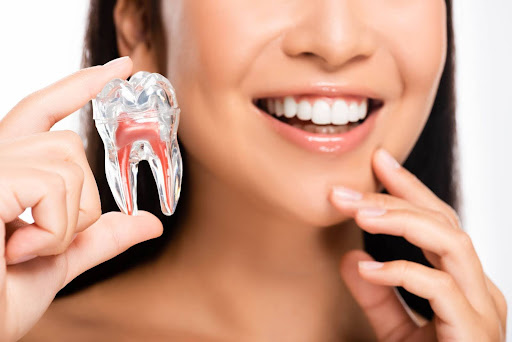A cracked tooth occurs when a crack extends from the chewing surface down towards the root. It is a common dental issue that can cause discomfort and complications if left untreated. Understanding how to treat a cracked tooth can help maintain oral health and prevent further damage.
With proper care and timely intervention, most cracked teeth can be treated effectively, allowing individuals to continue enjoying their daily activities without discomfort.
Types of Cracked Teeth
Let’s dive into the different types of cracked teeth, so you can spot any potential issues early on and keep your smile healthy.
1. Craze Lines
Craze lines are small and superficial cracks that appear on the outer enamel of the tooth. They are typically harmless and do not cause pain or sensitivity. These cracks are often a natural result of wear and tear on the teeth. They are usually considered cosmetic and do not pose structural concerns.
2. Fractured Cusp
Fractured cusps happen when a tiny part of the tooth’s chewing surface breaks away. This can lead to sharp edges on the tooth and may cause discomfort during chewing. The characteristics of fractured cusps include sharp edges on the tooth and discomfort while chewing.
3. Cracked Tooth
A cracked tooth has a crack that extends from the chewing surface toward the root, with varying severity and potential to extend below the gum line. Symptoms include intermittent pain, sensitivity, and discomfort while chewing.
4. Split Tooth
Split teeth show what a cracked tooth looks like when it has gotten worse as the tooth has split into segments. This can result in visible separation of tooth segments, significant pain or discomfort, and segments that may move independently.
5. Vertical Root Fracture
Vertical root fractures are cracks that start at the root of the tooth and extend upward toward the chewing surface. They are less common but can be more severe than other types of cracks. Vertical root fractures may not show obvious symptoms initially but can lead to infection and pain over time.
Triggers Behind the Cracks
Cracked teeth are often triggered by common actions or events. It is advisable to know the triggers beforehand to help you take safety precautions.
Biting Hard Foods
The force exerted while biting down on hard foods like ice, nuts, or hard candy can exceed the tooth’s strength, leading to a crack. Sudden changes in temperature (such as chewing ice followed by a hot beverage) can also contribute to the risk of cracking.
Trauma
Trauma can occur during sports activities such as falls, or impacts to the face. Wearing protective gear during high-risk activities can minimise the risk of dental injuries and cracked teeth.
Teeth Grinding
Bruxism, or teeth grinding, can occur during sleep or due to stress and anxiety. It exerts excessive pressure on the teeth, leading to wear and tear over time. Stress management techniques, relaxation exercises, and wearing a nightguard can reduce the risk of cracks.
Large Fillings
Large fillings weaken the tooth structure, especially if they are old or improperly placed. The remaining tooth around the filling may not provide sufficient support, making it prone to cracking, especially under pressure from chewing.
Age
Over time, teeth undergo wear and tear from chewing and use which leads to thinning enamel and changes in tooth structure. Age-related factors such as reduced saliva production and changes in jaw alignment can also contribute to cracked teeth.
Signs and Symptoms
Ever wondered how to tell if you have a cracked tooth? We will walk through the common signs and symptoms, so you know when to seek help from your dentist.
1. Pain
The pain may come and go and can vary in intensity. A cracked tooth can expose the sensitive inner layers of the tooth, leading to pain when pressure is applied during chewing or biting. The crack may also allow bacteria to enter, causing inflammation and pain.
2. Sensitivity
Cracks in the tooth enamel can expose the underlying dentin, which contains nerve endings. This exposure to external stimuli like temperature changes or sugary foods can trigger sensitivity.
3. Swelling
Inflammatory response to the crack or infection that may develop due to bacteria entering the crack can lead to swelling in the gums or tissues around the affected tooth.
4. Discomfort While Chewing
The movement of the cracked segments of the tooth during chewing can cause discomfort or pain, especially when pressure is released from the bite.
Navigating Treatment Options
When it comes to treating a cracked tooth, there are a few treatments you can take. Let’s explore your options together, so you can make the best choice for your dental care.
Bonding
A tooth-coloured resin is applied to the cracked tooth to fill the crack and restore its appearance and function. This helps protect the tooth from further damage and enhances its strength.
Root Canal
A root canal is a procedure used when the crack extends into the pulp (inner tissue) of the tooth. During a root canal, the damaged tissue is removed, and the tooth is cleaned and sealed to save it from extraction. A crown is usually used to protect the tooth after the root canal treatment is completed.
Extraction
If the tooth cannot be fixed, extraction might be needed in serious situations. This involves removing the cracked tooth from the mouth to prevent further complications and restore oral health.
The Road to Recovery
Recovering from a cracked tooth may seem scary, but with the right knowledge and steps, you will be back to smiling in no time.
1. Pain Management
Take non-prescription painkillers like ibuprofen or acetaminophen to ease any discomfort. Avoid aspirin, as it can increase bleeding if extraction is necessary.
2. Eating Soft Foods
Stick to soft foods like mashed potatoes, soups, and yogurt to avoid putting pressure on the cracked tooth. Refrain from chewing on the side that is affected to prevent more harm,
3. Oral Hygiene
Keep up with gentle brushing of your teeth twice daily and regular flossing. Use a soft-bristled toothbrush to avoid irritating the cracked tooth. Rinse with an antiseptic mouthwash to promote healing and prevent infection.
4. Follow-Up Appointments
Schedule regular follow-up appointments with your dentist to monitor the healing process and ensure no complications arise. Your dentist may recommend additional treatments or adjustments based on your progress.
Additional Tip: Apply a cold compress to the outside of your cheek near the cracked tooth for 10-15 minutes at a time to reduce swelling and alleviate pain.
Prevention Against Shattered Smiles
Nobody wants a shattered smile! Here are some simple yet effective ways to prevent cracked teeth and keep your smile bright and healthy:
1. Avoid Hard Foods
Steer clear of chewing on hard substances like ice, hard candy, popcorn kernels, and nuts. These foods can exert excessive pressure on your teeth, increasing the risk of cracks or fractures. Opt for softer alternatives to protect your dental health.
2. Wear Mouthguards
If you grind your teeth at night (bruxism) or participate in contact sports, wearing a mouthguard is essential. A custom-fit mouthguard can cushion your teeth and protect them from damage caused by grinding or impact during sports activities.
3. Regular Dental Check-Ups
Book regular dental appointments every six months. These visits allow your dentist to assess your oral health, detect any signs of dental issues such as cracks or decay early, and provide timely intervention or preventive treatments as needed.
4. Use Proper Technique
Avoid using your teeth as tools to open packages, bottles, or tear objects. Using your teeth for these purposes can lead to cracks, chips, or fractures. Instead, use appropriate tools or utensils to avoid putting unnecessary strain on your teeth.
Additional Tip: Use a straw when drinking sugary or acidic beverages to minimise direct contact with your teeth. This helps reduce enamel erosion and tooth decay. Rinse your mouth with water afterward to neutralise acidity and wash away sugars.
Final Thoughts
Dealing with a cracked tooth can be concerning, but with the right knowledge and prompt treatment, most issues can be effectively resolved. Good oral hygiene and preventive measures significantly reduce the risk of cracks. If symptoms arise, seek dental care promptly for the best outcome. Your dental health is important, and with proper care, you can maintain a healthy, pain-free smile.
For professional dental services and tailored treatment choices, do not hesitate to reach out to us!











